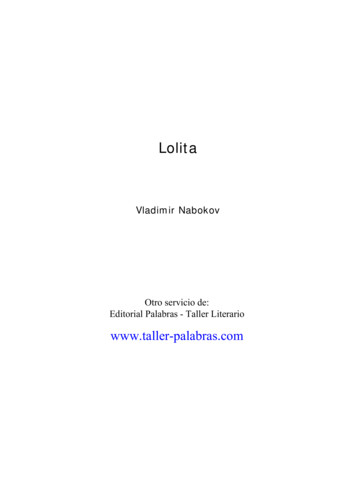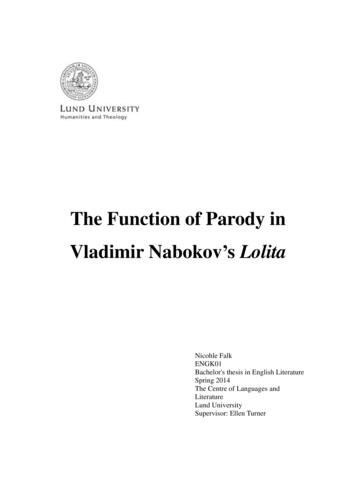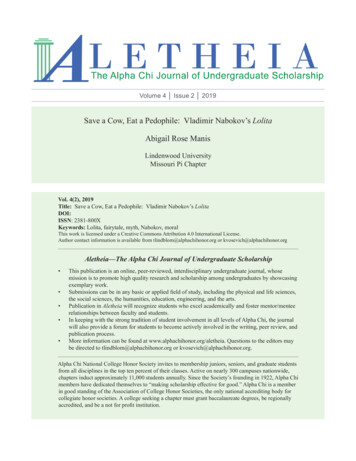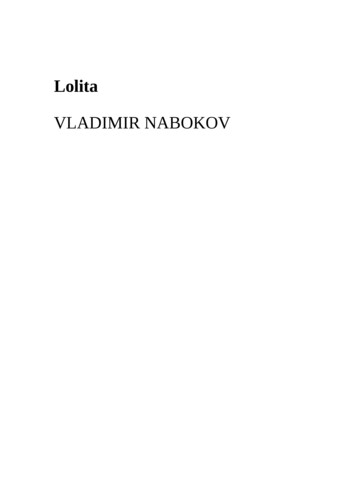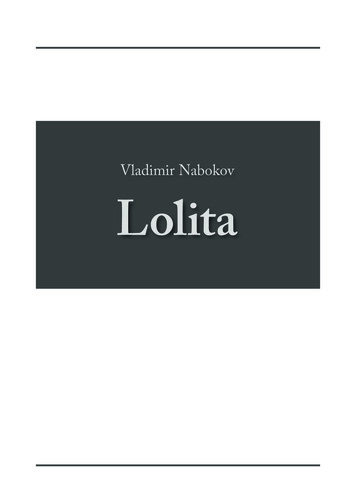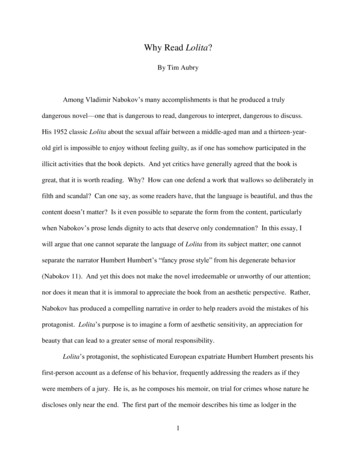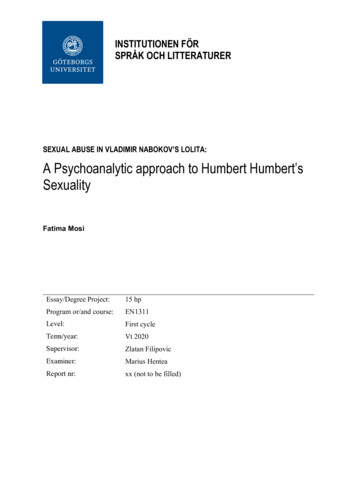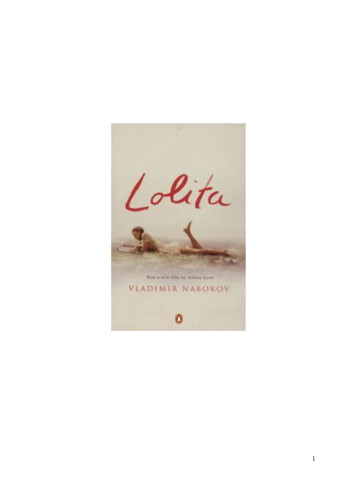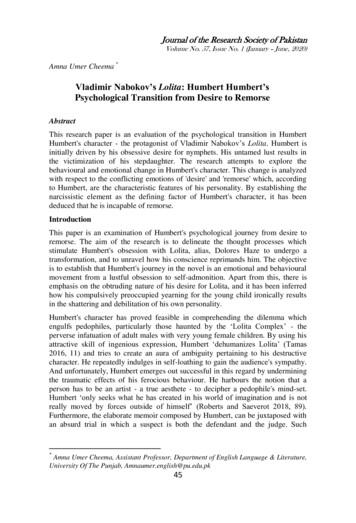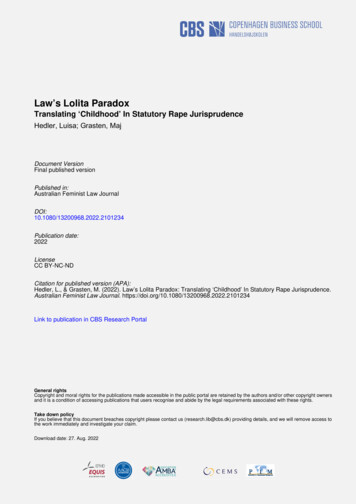
Transcription
Law’s Lolita ParadoxTranslating ‘Childhood’ In Statutory Rape JurisprudenceHedler, Luisa; Grasten, MajDocument VersionFinal published versionPublished in:Australian Feminist Law n date:2022LicenseCC BY-NC-NDCitation for published version (APA):Hedler, L., & Grasten, M. (2022). Law’s Lolita Paradox: Translating ‘Childhood’ In Statutory Rape Jurisprudence.Australian Feminist Law Journal. https://doi.org/10.1080/13200968.2022.2101234Link to publication in CBS Research PortalGeneral rightsCopyright and moral rights for the publications made accessible in the public portal are retained by the authors and/or other copyright ownersand it is a condition of accessing publications that users recognise and abide by the legal requirements associated with these rights.Take down policyIf you believe that this document breaches copyright please contact us (research.lib@cbs.dk) providing details, and we will remove access tothe work immediately and investigate your claim.Download date: 27. Aug. 2022
Australian Feminist Law JournalISSN: (Print) (Online) Journal homepage: https://www.tandfonline.com/loi/rfem20Law’s Lolita Paradox: Translating ‘Childhood’ InStatutory Rape JurisprudenceLuisa Teresa Hedler Ferreira & Maj GrastenTo cite this article: Luisa Teresa Hedler Ferreira & Maj Grasten (2022): Law’s Lolita Paradox:Translating ‘Childhood’ In Statutory Rape Jurisprudence, Australian Feminist Law Journal, DOI:10.1080/13200968.2022.2101234To link to this article: https://doi.org/10.1080/13200968.2022.2101234 2022 The Author(s). Published by InformaUK Limited, trading as Taylor & FrancisGroupPublished online: 16 Aug 2022.Submit your article to this journalArticle views: 90View related articlesView Crossmark dataFull Terms & Conditions of access and use can be found ation?journalCode rfem20
Australian Feminist Law Journal, AW’ S LOLITA PARADOX : TRANSLATING ‘CHILDHOOD ’ INSTATUTORY RAPE JURISPRUDENCELuisa Teresa Hedler Ferreira* and Maj Grasten**Abstract. This article addresses how normative views about ‘childhood’ aretranslated into statutory rape legislation and court judgments at the highestlegal level in Brazil, in the Federal Supreme Court. The article draws onliterature on the sociology of childhood to trace how courts translatesocietal narratives in the construction of agency, vulnerability andvictimhood with regard to children and sexuality. Analysing historical andcontemporary statutory rape legislation and Federal Supreme Courtdecisions over a 20-year period, we argue that the legal subjecthood of childvictims of sexual crimes is constructed at the intersection of prevailingnorms in society about childhood and moralising discourses about women’ssexuality. Deviating from norms about childhood results in the prominenceof women’s sexuality and sexual desire in legal and judicial argumentation,situating children in a legal-semantic space in which they are simultaneouslydenied the agency that characterises adulthood and the special protectionthat compensates for this lack of agency in childhood protection laws. Werefer to this legal situation and friction as the ‘Lolita paradox’ of statutoryrape jurisprudence.1.0 INTRODUCTIONHe had the utmost respect for ordinary children, with their purity and vulnerability, andunder no circumstances would he have interfered with the innocence of a child, if therewas the least risk of a row. But how his heart beat when, among the innocent throng, heespied a demon child, ‘enfant charmante et fourbe’, dim eyes, bright lips, ten years in jailif you only show her you are looking at her.1The picture formed is clearly astonishing, as we come to the conclusion that theminor, though so young, already led a promiscuous life and appeared to be older*PhD Fellow, Department of Management, Politics and Philosophy, Copenhagen Business School.Email: lthf.mpp@cbs.dk.**Assistant Professor, Department of Management, Politics and Philosophy, Copenhagen BusinessSchool.1Vladimir Vladimirovich Nabokov, Lolita (Knopf 1992) 20. 2022 The Author(s). Published by Informa UK Limited, trading as Taylor & Francis GroupThis is an Open Access article distributed under the terms of the Creative Commons Attribution-NonCommercialNoDerivatives License ), which permits non-commercial re-use, distribution, and reproduction in any medium, provided the original work is properly cited, and is not altered, transformed, orbuilt upon in any way.
2AUSTRALIAN FEMINIST LAW JOURNALthan she was. The statutory rape charges must cede in the face of the modification ofour mores. In our days there are no children, there are 12-year-old women.Precociously matured, the majority of them knows how to react to these situations,even if they don’t possess the adequate scale of values to know the consequences oftheir actions.2The quotations above, separated by time and place, express a similar construction ofsubjecthood based on the distinction between the idealised innocence of childhoodand the sexual agency of women. The first comes from the embattled protagonistof Vladimir Nabokov’s novel from 1955, Lolita, while the second is from a 1996 judgement on statutory rape charges from the Brazilian Supreme Court. In the lattercase, the Court’s description of the victim resulted in discrediting the complainantfor her failure to conform with the sexual and behavioural standards of the ‘idealchild rape victim’. The practice of law, James Boyd White argues in Justice as Translation, consists in translating general narratives into particular narratives acceptablein court.3 Translation, as this special issue on Law and Gender in Translationsuggests, is a powerful process of knowledge construction and circulation. Thelanguage of law, in turn, is a coercive instrument that serves not only to distributeabstract rights and obligations, but also to actively interfere in the lives of peoplethrough judicial decisions.4 Meanings of childhood in court narratives are instrumental for who is rendered vulnerable and who is attributed agency. Evidence in rape casestends to be the narratives that victims and defendants tell.5This article addresses how the agency of younger victims of sexual crimes is constructed in the courtroom and with what legal effects. We analyse the ways in whichconventional ideas about childhood and sexual norms are translated into statutoryrape cases by the argumentative practices of the defence and judges that constitutethe sociolegal boundaries of violence, vulnerability, and victimhood in these cases.Statutory rape is a criminal offence defined as sexual intercourse between an adultwith a person who has not yet reached the age of consent. The encounter does nothave to be forced or coerced to be defined as statutory rape. Our analysis draws on17 habeas corpus cases that reached the Federal Supreme Court of Brazil (STF) in2Supremo Tribunal Federal [Supreme Federal Court of Brazil], HC 73662 MG (21 May 1996)(Marco Aurélio DJ) (HC 73662 MG) (emphasis added).3James Boyd White, Justice as Translation: An Essay in Cultural and Legal Criticism (University ofChicago Press 1990). See also Sharon R Ullman, Sex Seen: The Emergence of Modern Sexuality inAmerica (University of California Press 1997); Wendy Larcombe, Compelling Engagements: Feminism, Rape Law and Romance Fiction (Federation Press 2005).4Eleonora Zicari Costa de Brito, Justiça e Gênero: Uma História Da Justiça de Menores em Brasília(1960–1990) [Justice and Gender: A History of Juvenile Justice in Brazil (1960–1990)] (Editora Universidade de Brasília 2007).5Lúcia Gonçalves De Freitas and Liliana Cabral Bastos, ‘Sexual Abuse in Proceedings of GenderBased Violence in the Brazilian Judicial System’ (2019) 13(2) Gender and Language 153; UlrikaAndersson, Monika Edgren, Lena Karlsson and Gabriella Nilsson (eds) Rape Narratives inMotion (Palgrave 2019); Zsuzsanna Adler, Rape on Trial (Routledge and Kegan Paul 1987);Joanna Bourke, Rape: A History from 1860 to the Present (Virago 2007); Clare McGlynn andVanessa E Munro (eds) Rethinking Rape Law: International and Comparative Perspectives (Routledge 2010); Joan McGregor, ‘The Legal Heritage of the Crime of Rape’ in Jennifer Brown and SandraWalklate (eds) Handbook on Sexual Violence (Routledge 2012) at 69.
LAW’S LOLITA PARADOX: TRANSLATING ‘CHILDHOOD ’ IN STATUTORY RAPE 3JURISPRUDENCEthe period from 1996 to 2013. In these cases, the defence argued that the presumptionof violence was relative, meaning that it could be overturned due to certain characteristics of the child victim. The article argues that the legal subjecthood of child victimsof sexual crimes is constructed at the intersection of prevailing norms in society aboutchildhood and moralising discourses about women’s sexuality. Deviating from normsabout childhood results in the prominence of women’s sexuality and sexual desire inlegal and judicial argumentation, situating children in a legal-semantic space in whichthey are concurrently denied the agency that characterises adulthood and the specialprotection that compensates for this lack of agency in childhood protection laws.6 Werefer to this legal situation and friction as the ‘Lolita paradox’ of statutory rapejurisprudence.The Anglo-American institution of habeas corpus is a procedure by which a highercourt may review the legality of a detention or imprisonment, ie ‘restraints on physical liberty’. Brazil was the first country in Latin America to adopt this proceduralinstitution in 1830.7 According to the Brazilian Constitution, ‘habeas corpus shallbe granted whenever a person suffers or is threatened with suffering violence or coercion in his freedom of movement through illegality or abuse of power’.8 In practice,however, habeas corpus is utilized much more broadly than the Code of Criminal Procedure indicates. As a result of how Brazil’s Supreme Court has construed its habeascorpus jurisdiction broadly, habeas corpus is routinely invoked to challenge the constitutionality of a criminal inquiry by a person required to testify, to challenge anindictment, to challenge a jury verdict or a criminal sentence,9 or even the constitutionality of law, statutes and decrees.10Habeas corpus cases at the Supreme Court level are a useful analytical resource fortwo reasons. First, these cases have reached the highest instance of appeal which testifies to the scope of the legal controversy around the matter. When habeas corpuscases reach the Supreme Court, it is not the facts of the case that are being judiciallyreviewed, but the interpretation of the law. Dissecting legal controversies permits usto see the more profound contradictions and paradoxes enshrined in law and the roleof contending interests in the development of jurisprudence. Since the STF is thehighest court in Brazil, it provides the most authoritative understanding in legalmatters, and therefore can be said to accurately represent general trends in the Brazilian judiciary.Second, juvenile criminal proceedings and records are, as a rule, confidential andthus sealed from public view. STF decisions involving minors are made public.However, this is only in part and what is made public depends on the judges’6We define agency as the capacity to act, including to make considered decisions based on practicalevaluation, within particular concrete life circumstances; see Mustafa Emirbayer and Ann Mische,‘What Is Agency?’ (1998) 103(4) American Journal of Sociology 962.7Keith S Rosenn, ‘Judicial Review in Latin America’ (1974) 35(4) Ohio State Law Journal 785.8Constitution of the Federative Republic of Brazil, ch 1 art 5 (LXVIII). Moreover, according to article5 (LXXVII), ‘habeas corpus and habeas data proceedings and, under the terms of the law, acts necessary to the exercise of citizenship are free of charge’.9Keith S Rosenn, ‘Procedural Protection of Constitutional Rights in Brazil’ (2011) 59(4) The American Journal of Comparative Law 1009, 1016.10As above.
4AUSTRALIAN FEMINIST LAW JOURNALdiscretion. What is revealed depends on what aspects of the case the judges find mostimportant and legally relevant, and creates important silences as to other aspects ofcases, notably race. Research has shown that race-based sexual stereotypes are bothhistorically conditioned and play an important role in how jurors and judges decide incases of child sexual abuse.11 Why the parts of STF decisions made public do notinclude the issue of race might be explained by the myth of ‘racial democracy’ inBrazil, where race, racism and racial inequality do not play a role in Braziliansociety.12 The relevant inequality is economic.13 This explains why this article’s analysis does not and cannot address the role race plays in the judicial process around statutory rape. Recently, civil society actors and legal scholars have challenged this myth,contending that racial discrimination plays an important role in the Brazil’s legalhistory.14The first case in our dataset of 17 habeas corpus cases was decided in the SupremeCourt in 1996. It sparked a considerable controversy among politicians and in themedia, whilst it established a significant precedent for the following habeas corpuscases on statutory rape. The last case reached the court in 2013. Since this date,there have been no new STF habeas corpus cases on statutory rape. This is becauseof the 2009 penal law reform in Brazil which amended the current Penal Code ofBrazil from 1940. Before 2009, statutory rape was defined by the presumption of violence in cases in which the victim was under the age of 14.15 This legal ambiguity wasreduced with the introduction of a new legal definition by which the mere act ofhaving sexual intercourse with anyone under the age of 14 would be classified asrape.16 The legal framework applied to the habeas corpus cases analysed in thisarticle dates from before the 2009 reform. While these cases were judged betweenDeborah Alley and others, ‘Race-Based Sexual Stereotypes Influence Ratings of Child Victims inSexual Abuse Cases’ (2019) 2(3) International Journal on Child Maltreatment 287; Bette L Bottoms,Suzanne L Davis and Michelle A Epstein, ‘Effects of Victim and Defendant Race on Jurors’Decisions in Child Sexual Abuse Cases’ (2004) 34(1) Journal of Applied Social Psychology 1;Rachel A Feinstein, When Rape Was Legal: The Untold History of Sexual Violence DuringSlavery (Routledge 2018). On the role of race on understandings of legal minority and age ofconsent, see Ishita Pande, Sex, Law, and the Politics of Age: Child Marriage in India, 1891–1937(Cambridge University Press 2020); Elizabeth Thornberry, ‘The Problem of African Girlhood:Raising the Age of Consent in the Cape of Good Hope, 1893–1905’ (2020) 38(1) Law and HistoryReview 219.12Stanley R Bailey, ‘Group Dominance and the Myth of Racial Democracy: Antiracism Attitudes inBrazil’ (2004) 69(5) American Sociological Review 728; France Winddance Twine, Racism in a RacialDemocracy: The Maintenance of White Supremacy in Brazil (Rutgers University Press 1997).13Evandro Piza Duarte, ‘O Debate Sobre as Relações Raciais no Brasil e seus Reflexo no Ordenamento Jurídico Brasileiro’ [The Debate on Racial Relations and Its Consequences in the BrazilianLegal System] (2004) 1 Universitas Jus 110.14Marcos Vinícius Lustosa Queiroz, Constitucionalismo Brasileiro e o Atlântico Negro: A Experiência Constitucional de 1823 diante da Revolução Haitiana [Brazilian Constitutionalim and the BlackAtlantic: The Constituent Experience of 1823 in the Face of the Haitian Revolution] (LumenJuris 2021, 3rd edn); Flavia Rios, ‘O Protesto Negro no Brasil Contemporâneo (1978-2010)’ [TheBlack Protest in Contemporary Brazil (1978–2010)] (2012) 85 Lua Nova: Revista de Cultura e Politica[New Moon: Journal of Culture and Politics] 41.15Código Penal [Penal Code] (Brazil) 7 December 1940.16Lei n 12.015, de 7 de Agosto de 2009 [Law No 12015 of 7 August 2009] (Brazil).11
LAW’S LOLITA PARADOX: TRANSLATING ‘CHILDHOOD ’ IN STATUTORY RAPE 5JURISPRUDENCE1996 and 2013, the facts of the individual cases took place before the current lawswere in force and were therefore judged under the previous laws. As such, we cantrace how the defence and judges constructed different narratives about the child’sidentity as a victim under the same law, in response to the diversity of situationsand arguments presented in each case, and conditioned how ideas about childhoodand sexual norms were translated into the Court. We identify three different narratives, two of which evolve around the ‘Lolita paradox’. To reconstruct processes oftranslating, we coded the court decisions in two steps. The first round focused exclusively on assigning codes to descriptions of the ‘victim’ and the ‘accused’. In a secondround, we grouped our codes into categories identifying and dividing ‘victimhood’according to three narratives in which ‘childhood’ intersected with women’s sexualityin statutory rape jurisprudence: the corrupted child, the innocent child, and the vulnerable child.The article contributes to socio-legal literature on the role of courts in framingsexual violence through their construction of the subjects,17 particularly the relationship between assumptions about agency, vulnerability and victimhood,18 as well ascritical legal scholarship on how law ‘sexes’ its subjects and, in consequence, reproduces unequal power relations.19 Complainants in rape cases are especially often discredited if they fail to comply with ideas of the ‘genuine’ rape victim, associated withtraits of moral and sexual virtue and a lack of provocativeness.20 We draw on literature in the field of the sociology of childhood21 to show how social discourses relatedto children and childhood simultaneously construct an ideal of childhood as both aphase of innocence and sexual ignorance22 and the child as a deviant subject, who isexcluded from social and legal protection in society due to ‘atypical behaviour’. In the17Anthony G Amsterdam and Jerome Bruner, Minding the Law: How Courts Rely on Storytelling,and How Their Stories Change the Way We Understand Law – And Ourselves (Harvard UniversityPress 2000); Peter Brooks, ‘Narrativity of the Law’ (2002) 14(1) Law and Literature 1; Lynn SChancer, High-Profile Crimes: When Legal Cases Become Social Causes (Chicago University Press2005); Kristin Bumiller, In an Abusive State: How Neoliberalism Appropriated the Feminist Movementagainst Sexual Violence (Duke University Press 2008).18Ulrika Andersson, ‘Harmed Selves Harming Others: A Vulnerability Approach to the CriminalJustice System’ in Martha Albertson Fineman, Ulrika Andersson and Titti Mattsson (eds) Privatization, Vulnerability and Social Responsibility: A Comparative Perspective (Routledge 2016) at 290;Martha Albertson Fineman, ‘The Vulnerable Subject: Anchoring Equality in the Human Condition’ (2008) 20(1) Yale Journal of Law and Feminism 1; Nicola Lacey, ‘Unspeakable Subjects,Impossible Rights: Sexuality, Integrity and Criminal Law’ (1997) 8(2) Women: A Cultural Review143; Rebecka Stringer, ‘Vulnerability after Wounding: Feminism, Rape Law and the Difference’(2013) 42(3) SubStance 148.19Brito, above note 4; Susan Ehrlich, Representing Rape: Language and Sexual Consent (Routledge2001).20Wendy Larcombe, ‘The “Ideal” Victim v Successful Rape Complaints: Not What You MightExpect’ (2002) 10(2) Feminist Legal Studies 131.21Chris Jenks, Childhood (Routledge 2005, 2nd edn); Michael G Wyness, Childhood and Society(Macmillan Education 2019, 3rd edn); Paula S Fass, ‘Children and Globalization’ (2003) 36(4)Journal of Social History 963; Göran Therborn, ‘Child Politics: Dimensions and Perspectives’(1996) 3(1) Childhood 29; Martin Woodhead and Heather Montgomery, Understanding Childhood:An Interdisciplinary Approach (Wiley Press 2003).22See, for example, Michel Foucault, The History of Sexuality: 1 (Penguin Classics 2020).
6AUSTRALIAN FEMINIST LAW JOURNALspecific case of child victims of statutory rape, these ideals of innocence (or theabsence of innocence) play a key role in constructing narratives of the ‘idealvictim’ in the courtroom and, importantly, the victim’s agency. These narrativesare instrumental in determining whether the child victim falls within the scope oflegal protection against sexual contact with adults. ‘Lolita’ is used in this article todenote the ambiguous and dynamic relationship between childhood innocence andfemale sexuality, which has the power of inverting the polarity between victim andperpetrator in statutory rape cases.23While the legal discussion surrounding rape already faces heavy discussions aboutthe level of agency that the victim has in each situation (Small, 2020), the discussionsabout agency become even more complex when involving child victims. Their agency– especially when it comes to sexual consent – is explicitly denied by the law until acontingent, variable cut-off point under which any sexual contact can be consideredstatutory rape.The article is structured in four parts. In the following section, we draw on thesociology of childhood to discuss how the agency of children is constructed (anddenied) via dominant ideas about ‘children’ in society. We point to how these ideasabout childhood translate into legal concepts in the development of children’srights. We then turn to outlining different iterations of rape laws in Brazil, includingstatutory rape, highlighting the influence of the traditional legal category of ‘honestwomen’ on the criminalisation of sexual violence against women. In a fourth section,we analyse 17 habeas corpus statutory rape cases (1996–2013) in which the defenceargued that the child victim consented to sexual contact. We point to how generalnarratives about childhood and sexuality translated into the interpretation of thelegal framework and argumentative practices applied in the courtroom of thehighest legal instance of Brazil, the STF.2.0CONSTRUCTING CHILDHOOD IN LAW AND SOCIETYSocially dominant views of childhood are potentially problematic when they aretranslated into law.24 A key function of law is to reduce the complexities ofreality into manageable propositions by imposing fixed concepts and normativeand moral judgments in processing these concepts.25 This regulates and stabilisessocial expectations and frames social conflicts in a way that a resolution throughjudicial sentence is made possible.26 The legal system and doctrines maintain thenormative and epistemic boundaries of childhood in its reduction of conflictingconstructions of ‘the child’ and children’s rights, in particular in their interaction23Graham Vickers, Chasing Lolita: How Popular Culture Corrupted Nabokov’s Little Girl All overAgain (Chicago Review Press 2008); see also Brito, above note 4.24See, for instance, John Eekelaar, ‘The Emergence of Children’s Rights’ (1986) 6(2) Oxford Journalof Legal Studies 161; Andrew Bainham, ‘The Privatisation of the Public Interest in Children’ (1990)53(2) Modern Law Review 206.25Allison James and Adrian L James, Constructing Childhood: Theory, Policy and Social Practice(Palgrave Macmillan 2004) 80.26Niklas Luhmann, ‘Law as a Social System’ (1989) 83(1–2) Northwestern University Law Review136.
LAW’S LOLITA PARADOX: TRANSLATING ‘CHILDHOOD ’ IN STATUTORY RAPE 7JURISPRUDENCEwith notions of family and sexuality. We draw on sociological studies of childhood to trace how law translates and thus absorbs discourses about childhood.A sociology of childhood argues that the concept of ‘childhood’ is an abstractionused to summarise and identify a biological basis for differentiating and classifyinghuman beings.27 Childhood ‘is not a natural category but one constructed viasocial ideas and institutions that create boundaries irreducible to physical or maturational difference’.28 These institutions include legal conventions, as well as ‘lastinginstitutional forms like families, nurseries, schools and clinics, all agencies specificallydesigned and established to process the child as a uniform entity’.29 Since ‘childhood’is commonly recognised in society as a biological process (rather than a social construction), which ends with the child’s final transformation into a rational adult, children are relegated to an ontological place of ‘becoming’.30 This perceived ontologicalincompleteness facilitates the negation of children’s agency regarding their ownexperiences, even in matters where they are the main concern.31Sociological scholarship on childhood suggests that there are two main archetypes based on which Western societies construct ideas about childhood.32 Eacharchetype is related to a particular mode of social control.33 While these archetypescan be analytically distinguished in terms of how they perceive the innate nature ofchildren and the nature of power relations in which children are embedded, theyoften coexist in social – and legal – discourses about childhood.34 In Nabokov’sLolita, for instance, the child – Dolores Haze/Lolita – is made sexually desirable(and deviant) because of (and not despite of) a romantic view of child innocence.One archetype is the ‘Dionysian child’, compatible with a negative Hobbesian perception of human nature.35 This conception of ‘childhood’ has been shaped inWestern culture by the doctrine of ‘original sin’ in Christianity. It imbues adult authorities with the task of turning ‘uncivilised’ children into moral and social beingsthrough, for instance, the use of physical punishment, to beat the evil tendencies ofthe child into submission.36 The mode of control is one of ‘rigid codes of behaviourwith little opportunity for individuality’.37 Though this archetype, conveying the ideaof hedonistic savagery being the natural state of the youth, is historically situated inpre-nineteenth century Europe, Chris Jenks suggests that it transcends this period;3827Jenks, above note 21 at 6; Wyness, above note 21 at 8; see also Philippe Ariès, Centuries of Childhood: A Social History of Family Life (Vintage Books 1965).28Vikki Bell, ‘Governing Childhood: Neo-Liberalism and the Law’ (1993) 22(3) Economy andSociety 390, 391.29Jenks, above note 21 at 12.30As above at 4.31Fass, above note 21 at 963.32See, for example, Jenks, above note 21; Wyness, above note 21; Woodhead and Montgomery, abovenote 21.33Karen Smith, ‘Producing Governable Subjects: Images of Childhood Old and New’ (2011) 19(1)Childhood 24.34Jenks, above note 21 at 64.35Woodhead and Montgomery, above note 21 at 63.36Jenks, above note 21 at 63.37Smith, above note 33 at 26.38As above at 54.
8AUSTRALIAN FEMINIST LAW JOURNALfor instance, in Freudian conceptions about human nature and desires of early childhood.39 It can be argued that this conception still has considerable impact on howchildhood is commonly conceived today.40In contrast to the ‘Dionysian child’, the ‘Apollonian child’ is based on a ‘romantic’ view of children, which emphasises positive and desirable aspects of childhood.41Children are perceived as being untainted, innocent and angelic; special and uniquebeings to be worshipped and adored.42 However, the Apollonian child is equally seenas standing outside society, which belongs to the adult rational world. The powerexerted upon this type of child differs from the Dionysian approach. Focus shiftsfrom correction and control to the protection of child innocence, through ‘monitoring the child in mind and body’.43 This perception of childhood coincides with children becoming an object of special legal status in the nineteenth century. In thecontext of the formation and consolidation of Western nation-states, the state wasgranted the authority to intervene in the welfare of children, who were hitherto considered the sole property of parents.44Traditionally, the Brazilian legal framework, transplanted from Portuguese medieval law through colonisation, protected the family as a collective under the leadership of adult men.45 Children were primarily characterised by their lack of agency andcomplete submission to paternal authority. The 1927 Minor Code (Código deMenores), the first child protection law in Brazil, provided the State with a set ofmeasures to address minors (defined as under the age of 18) who were either abandoned or considered ‘delinquents’.46 These measures included the right to eitherprovide for or punish children if their family failed to do so. Moreover, the MinorCode included provisions for protecting children from exposure to ‘libertine practices’ by adults, such as prostitution or behaviour that might ‘harm the modesty ormorality of the minor, or provoke their bad or immoral instincts’.47 The domesticpromotion of children’s rights was influenced by several global developments, including the International Labour Organisation’s (ILO) 1919 Minimum Age (Industry)Convention and transnational alliances of scientists and health professionals publishing on child mortality, health and labour.48A more agentic understanding of children as individual subjects of rightsemerged in the late 1970s with the development of the international human rightsLutz DH Sauerteig, ‘Loss of Innocence: Albert Mol, Sigmund Freud and the Invention of Childhood Sexuality around 1900’ (2012) 56(2) Medical History 156.40See, for instance, Vickers, above note 23.41Woodhead and Montgomery, above note 21 at 65.42Jenks, above note 21 at 64–5.43As above at 68.44Therborn, above note 21 at 29–30.45Mariana de Moraes Silveira, ‘Direito, Ciência Do Social: O Lugar dos Juristas Nos Debates doBrasil dos Anos 1930 e 1940’ [Law, Science of the Social: The Place of Jurists in the Debates of Brazilin the 1930s and 1940s] (2016) 29(58) Estudos Históricos 441.46Decreto No 17.943-A de 12 de Outubro de 1927 [Decree No 17.943-A of 12 October 1927] (Brazil)art 1.47As above at art 113.48Nina Schneider, ‘Origins of Child Rights Governance: The Example of Early Child Labour Legislation in the United States and
Law's Lolita Paradox Translating 'Childhood' In Statutory Rape Jurisprudence Hedler, Luisa; Grasten, Maj Document Version Final published version Published in: Australian Feminist Law Journal DOI: 10.1080/13200968.2022.2101234 Publication date: 2022 License CC BY-NC-ND Citation for published version (APA): Hedler, L., & Grasten, M. (2022).
